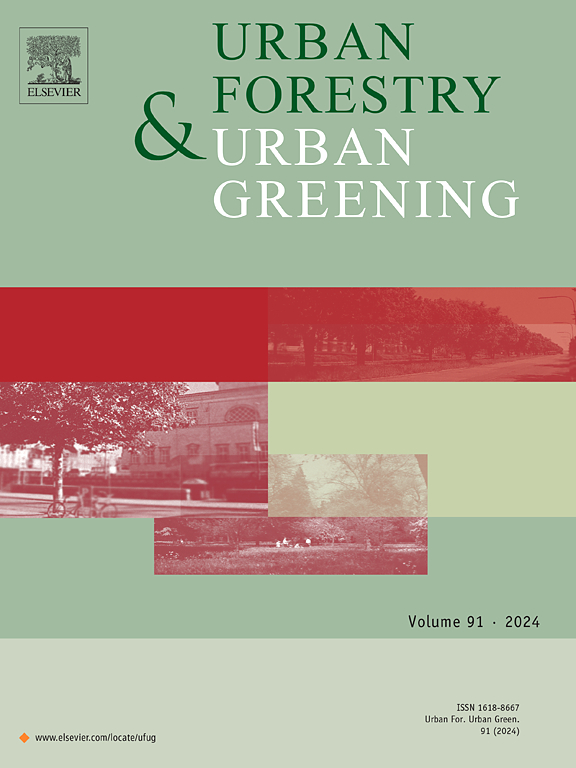Urban vegetation productivity under climate change and increasing urbanization: Insights from both urban-rural comparison and trend analysis for global cities
IF 6
2区 环境科学与生态学
Q1 ENVIRONMENTAL STUDIES
引用次数: 0
Abstract
Under increasing urbanization and global climate change, the coverage and growth state of urban vegetation have experienced profound changes, but how they affect urban vegetation productivity remains unclear. Here, we used satellite-derived near-infrared reflectance of vegetation (NIRv, a proxy of gross primary productivity) and global long-term 30 m landcover datasets to examine the spatial differences and temporal dynamics of urban vegetation cover and productivity for 1782 cities worldwide. Spatially, urban vegetation productivity is prevalently higher than that in nearby rural backgrounds (+31.77 % ± 49.55 %), with greater enhancement ratio in highly urbanized blocks. From the temporal perspective, urban vegetation productivity generally increased (1.07 % ± 0.96 % per year) despite substantial loss of vegetation cover (–0.51 ± 0.42 percentage points per year) during 2001–2020. Globally, climate changes-dominated background changes made greater contributions (0.71 % ± 0.75 % per year) to the increasing urban vegetation productivity than urbanization-induced local changes (0.47 % ± 0.87 % per year). Notable differences in the local changes of vegetation productivity were observed within cities, as new urban areas had greater increasing trends than old urban areas. The local changes in urban vegetation productivity are primarily determined by the intensity of urbanization and its changes, further modulated by city’s climatic and socioeconomic conditions. By separating the effects of vegetation cover and productivity changes on observed vegetation dynamics, our findings deepen the understanding of urban vegetation changes and provide valuable reference for building greener cities.
气候变化与城市化进程下的城市植被生产力:城乡对比与全球城市趋势分析
在城市化进程加快和全球气候变化的背景下,城市植被覆盖度和生长状态发生了深刻变化,但其对城市植被生产力的影响机制尚不清楚。本文利用卫星获取的植被近红外反射率(NIRv, gross primary productivity的代表)和全球30 m长期土地覆盖数据集,研究了全球1782个城市的城市植被覆盖和生产力的空间差异和时间动态。从空间上看,城市植被生产力普遍高于邻近农村背景(+31.77 %±49.55 %),且高度城市化街区的增强率更高。从时间上看,2001-2020年期间,尽管植被覆盖大幅减少(-0.51 ± 0.42个百分点/年),但城市植被生产力总体增加(1.07 %±0.96 % /年)。在全球范围内,气候变化主导的背景变化对城市植被生产力增长的贡献(0.71 %±0.75 % /年)大于城市化引起的局地变化(0.47 %±0.87 % /年)。城市内部植被生产力的局地变化差异显著,新城区的增长趋势大于旧城区。城市植被生产力的局部变化主要由城市化强度及其变化决定,并受城市气候和社会经济条件的进一步调节。通过分离植被覆盖度和生产力变化对观测植被动态的影响,加深了对城市植被变化的认识,为建设绿色城市提供了有价值的参考。
本文章由计算机程序翻译,如有差异,请以英文原文为准。
求助全文
约1分钟内获得全文
求助全文
来源期刊

Urban Forestry & Urban Greening
FORESTRY-
CiteScore
11.70
自引率
12.50%
发文量
289
审稿时长
70 days
期刊介绍:
Urban Forestry and Urban Greening is a refereed, international journal aimed at presenting high-quality research with urban and peri-urban woody and non-woody vegetation and its use, planning, design, establishment and management as its main topics. Urban Forestry and Urban Greening concentrates on all tree-dominated (as joint together in the urban forest) as well as other green resources in and around urban areas, such as woodlands, public and private urban parks and gardens, urban nature areas, street tree and square plantations, botanical gardens and cemeteries.
The journal welcomes basic and applied research papers, as well as review papers and short communications. Contributions should focus on one or more of the following aspects:
-Form and functions of urban forests and other vegetation, including aspects of urban ecology.
-Policy-making, planning and design related to urban forests and other vegetation.
-Selection and establishment of tree resources and other vegetation for urban environments.
-Management of urban forests and other vegetation.
Original contributions of a high academic standard are invited from a wide range of disciplines and fields, including forestry, biology, horticulture, arboriculture, landscape ecology, pathology, soil science, hydrology, landscape architecture, landscape planning, urban planning and design, economics, sociology, environmental psychology, public health, and education.
 求助内容:
求助内容: 应助结果提醒方式:
应助结果提醒方式:


